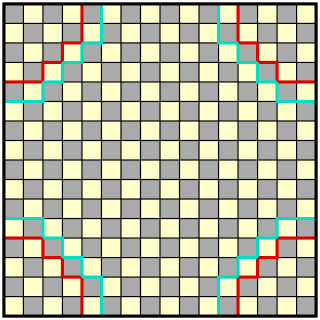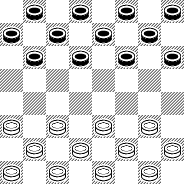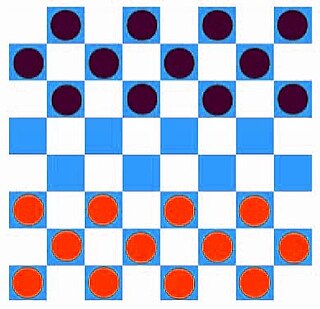
Sternhalma, commonly known as Chinese checkers or Chinese chequers, is a strategy board game of German origin that can be played by two, three, four, or six people, playing individually or with partners. The game is a modern and simplified variation of the game Halma. "Complexity: requires no counting or spelling; even young children can play."

Checkers, also known as draughts, is a group of strategy board games for two players which involve diagonal moves of uniform game pieces and mandatory captures by jumping over opponent pieces. Checkers is developed from alquerque. The term "checkers" derives from the checkered board which the game is played on, whereas "draughts" derives from the verb "to draw" or "to move".

Halma is a strategy board game invented in 1883 or 1884 by George Howard Monks, an American thoracic surgeon at Harvard Medical School. His inspiration was the English game Hoppity which was devised in 1854.

International draughts is a strategy board game for two players, one of the variants of draughts. The gameboard comprises 10×10 squares in alternating dark and light colours, of which only the 50 dark squares are used. Each player has 20 pieces, light for one player and dark for the other, at opposite sides of the board. In conventional diagrams, the board is displayed with the light pieces at the bottom; in this orientation, the lower-left corner square must be dark.

Quarters is a drinking game which involves players bouncing an American quarter or similar-size coin off a table in an attempt to have the quarter land in a certain place, usually into a shot glass on that table. It is also played in South America, where it is called "monedita," Spanish for little coin.

English draughts or checkers, also called straight checkers or simply draughts, is a form of the strategy board game checkers. It is played on an 8×8 checkerboard with 12 pieces per side. The pieces move and capture diagonally forward, until they reach the opposite end of the board, when they are crowned and can thereafter move and capture both backward and forward.
Portable Draughts Notation (.PDN) is the standard computer-processable format for recording draughts games. This format is derived from Portable Game Notation, which is the standard chess format.

Lasca is a draughts variant, invented by the second World Chess Champion Emanuel Lasker (1868–1941). Lasca is derived from English draughts and the Russian draughts game bashni (Towers).
Kruzno is a two-player abstract strategy board game played on a hexagonal board, first published in 2005 by the company of the same name.

Turkish draughts (Armenian: շաշկի)(Arabic: دامە)(Kurmanji: دامە) is a variant of draughts (checkers) played in Turkey, Greece, Egypt, Kuwait, Lebanon, Syria, Jordan and several other locations around the Mediterranean Sea and Middle East.

Russian draughts is a variant of draughts (checkers) played in Russia and some parts of the former USSR, as well as parts of Eastern Europe and Israel.
Dablo is a family of two-player strategy board games of the Sámi people. Different variants of the game have been played in different parts of Sápmi.

Armenian draughts, or Tama, is a variant of draughts played in Armenia. The rules are similar to Dama. Armenian draughts, however, allows for diagonal movement.

Emergo is an abstract strategy game created by Christian Freeling and Ed van Zon in 1986. It belongs to the "stacking" category of games, or column checkers, along with Bashni and Lasca. The name comes from the motto of the Dutch province of Zeeland: Luctor et emergo meaning: "I wrestle and emerge". The goal of the game is to capture all of the opponents pieces similar to checkers/draughts. Emergo, and all column checkers, differ from most draughts variants because of their unique method of capture. A opponent's piece is added to the capturing player's column rather than being removed. Men can be recaptured from an opponent later on in the game.

Brazilian draughts is a variant of the strategy board game draughts. Brazilian Checkers follows the same rules and conventions as International draughts, the only differences are the smaller gameboard, and fewer checkers per player.

Poddavki, also known as Giveaway checkers, Suicide checkers, Anti-checkers or Losing draughts is a draughts (checkers) game based on the rules of Russian draughts, with the variation that a player wins if they have no legal moves on their turn, either by giving up all their pieces or having them all blocked. As in most varieties of draughts, capturing is mandatory. The game is played in Russia and some parts of the former Soviet Union.

Bashni, also known as column draughts, multi-level checkers, and rarer Chinese checkers, is a variation of draughts, known in Russia since the 19th century. The game is played according to the basic rules of Russian draughts, with the main difference being that draughts being jumped over are not removed from the playing field but are instead placed under the jumping piece . The resulting towers move across the board as one piece, obeying the status of the upper draught. When a tower is jumped over, only the upper draught is removed from it. If, as a result of the combat, the top draught changes colour, ownership of the tower passes on to the opposing player. Based on Bashni, but according to the basic rules of English draughts, world chess champion Emanuel Lasker developed the draughts game "Laska" and, in 1911, published its description. Lasker described towers that can only be "double-layered": i.e. there can be no alternation of colors. He also showed that during the game the number of game pieces either remains constant or decreases. Column draughts are a subject of interest for the mathematical Sciences: combinatorics, theory of paired zero-sum games, etc.

Tanzanian draughts is a variant of draughts (checkers) board game played usually in Tanzania. This is the strategy game that is played by two people using pieces on board. The game is very similar to Czech draughts but in this type the player can capture using king or men, there is no priority for that. Apart from that they are completely similar in any way. The game is also somehow similar to American checkers and Shashki in case of starting position. So Tanzanian draughts can be simply explained as "American checkers with flying king". King flies and captures the same like in Czech draughts does. Like many other kinds of draughts, there is possibility that either player can win the game or draw can be offered but this is based on the negotiations of players or supporters of the game.

Malaysian checkers or Singaporean checkers, is a variant of the board game of draughts played primarily in Malaysia and Singapore, especially among the elder men. Similar to the Canadian checkers, it is played on a 12x12 checkered board. The game can also be played on a 8x8 board if a 12x12 board is unavailable. However, it is distinct from Checkers and Canadian Checkers in terms of its additional rules. Popular alternative names used locally for this game include Dum and Dam.
Frisian draughts is a variant of draughts native to Friesland in the Netherlands.The rules are similar to International draughts, but is notable for its unique feature of allowing for orthogonal captures in addition to the familiar diagonal capture of most draughts variants.













